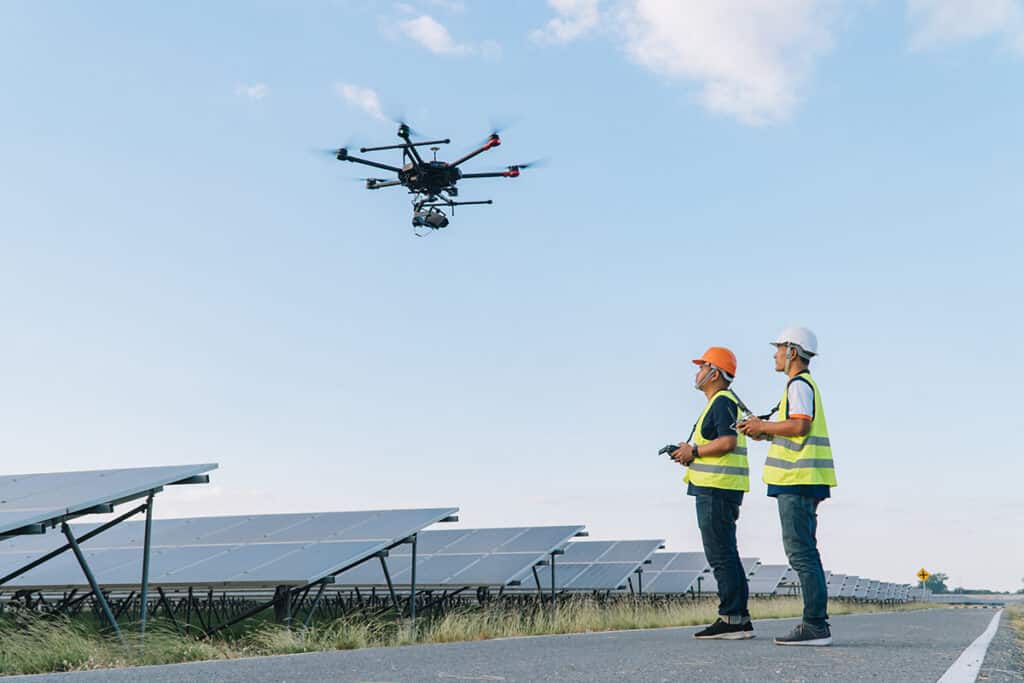What Makes Tethered Drones So Special?
Did you know not all drones are free-flying?
Have you ever seen drones attached to a cable and wondered what they were?
Tethered drones are part of the UAV ecosystem, perfectly suited for a wide variety of uses.
While free-flying drones are probably what comes to mind when you think of UAVs, tethered drones serve vital roles in security operations and defense functions.
Need a drone that can stay in a single spot for hours on end?
Need to operate a static security position or monitor large areas (supply yards or shipping ports, for example)?
If so, tethered drones provide the solution you’ve been looking for.
What are Tethered Drones?
Tethered drone systems are made up of three distinct components.
First, and most obvious, is the drone itself.
Typically, this involves a multirotor UAV, especially quadcopters.
The tether, or cable, is the next piece of the puzzle.
This cable serves as a conduit for data transfer, but most importantly, connects the drone to a continuous power source.
Finally, the ground control station houses the tether winch and the controls needed to raise and lower the drone.
Now, you can create tethered drone systems in two different ways.
First, it’s possible to modify free-flying drones to accept a tether, even if they weren’t manufactured for tethered operations.
The second type is a tethered drone system by design.
As you would expect, tethered drone systems work best when all three components are engineered and manufactured together.
The Benefits of Tethered Drones
The most common power sources for untethered drones include LiPo batteries, hydrogen, and gasoline.
Though the freedom of movement is nearly unlimited, carrying the fuel source onboard significantly limits flight duration.
For example, even the most impressive LiPo battery designs only deliver about one hour’s worth of flight time, while most commercial drones only last 20-30 minutes.
However, if your operational needs require lengthy flight times, you need a better solution.
This is where tethered drones shine.
Using a generator or other external source as the drone’s fuel, tethered drones can remain in the air for hours, even days.
Additionally, the ease of operation is drastically improved.
Untethered drones require the skills of a trained pilot for safe and efficient operations.
Here, maneuvering a drone safely requires someone who understands airspace restrictions, weather conditions, and aerodynamics.
However, a tethered drone’s cable keeps it in relatively the same spot. The raising and lowering of the drone is all that is required.
With far less training, a single person can easily perform all flight functions required of the aircraft.
Use Cases
There are many use cases for tethered drone systems, including traffic control, monitoring large outdoor crowds, and creating pop-up telecommunications sites.
But by far, the most useful employment is for security and surveillance operations.
Locations such as border checkpoints, military bases, shipping ports, and airports are excellent sites for tethered drone use.
The permanent or semi-permanent nature of these facilities requires a certain force protection level.
Cameras on tethered drones offer relatively constant eyes in the sky.
Vehicle checkpoints, entry and exit points for foot traffic, and large open areas are easily monitored with tethered drone systems.
The Limitations of Tethered Drones
Though flight times of over 24 hours are impressive, tethered drones do have a few limitations.
And, depending on the nature of your operation, some may be more important than others.
The payload for tethered drones is limited compared to other devices with lengthy flight durations.
For example, aerostat balloons can remain airborne for many days, and carry payloads of several thousand pounds.
However, tethered drones usually have the same payload weight limits as their free-flying UAV counterparts.
While the cable does provide power and a path for data transfer between the drone and the ground control station, it also limits where your drone can fly.
Essentially, the drone can only move within the length of its tether, like a dog on a leash.
The design also makes it difficult to fly when overhead obstructions are present.
Finally, the portability of tethered drones remains an important issue.
Because tethered drones require an external power source, they’re only as portable as your source.
If your goal is keeping watch over the same location, like guarding a port, warehouse, or airport, this probably isn’t a problem.
However, if your work requires moving to different locations, then it can become an issue.
At the very least, you’ll need a mobile power source, or a vehicle-mounted system.
For this reason, if your primary goal is portability and ease of travel, tethered drone systems might not be the best choice for you.
The Takeaways
Tethered drone systems are ideal for static security positions and where long-term surveillance is required.
While these systems lack some of the mobility of free-flying drones, the ability to stay airborne for hours, or even days, is a huge advantage in the right situations.
While portability can become an issue, the trade-off in flight time can be well worth the effort.
If you’re wondering if tethered drones are the right solution for you, speak with the professionals at Consortiq and find out today.

David Daly - Contributing Author
David Daly, is an award-winning photographer/writer and licensed (FAA) Commercial sUAS pilot. A graduate of the United States Naval Academy, David is a former Marine Corps officer with a BS in Oceanography and has earned his MBA from the University of Redlands. David has worked for Fortune 100 companies and has a background in aerospace, construction, military/defense, real estate, and technology.



